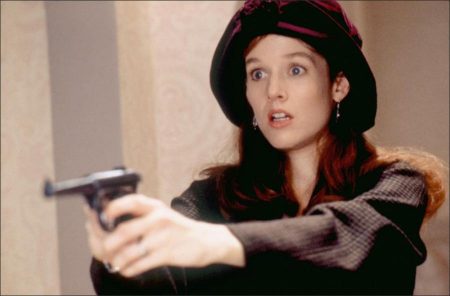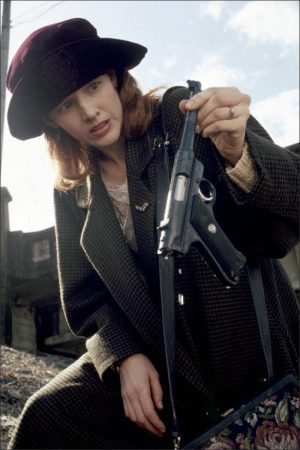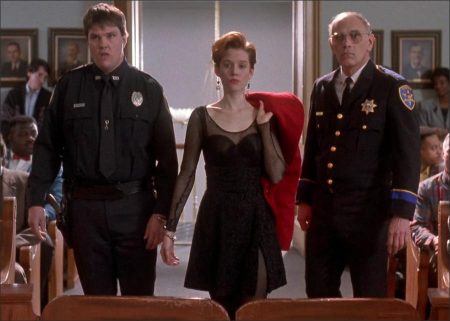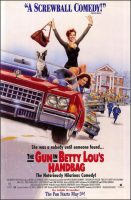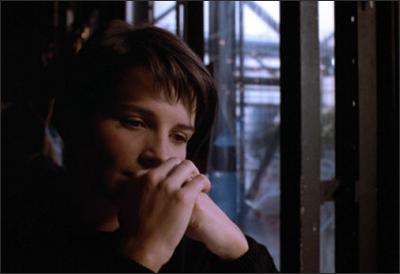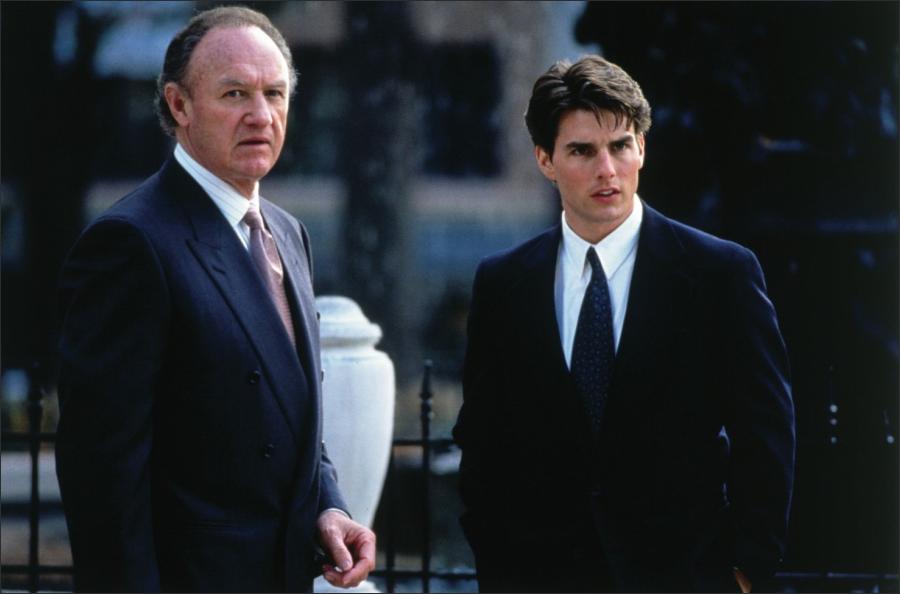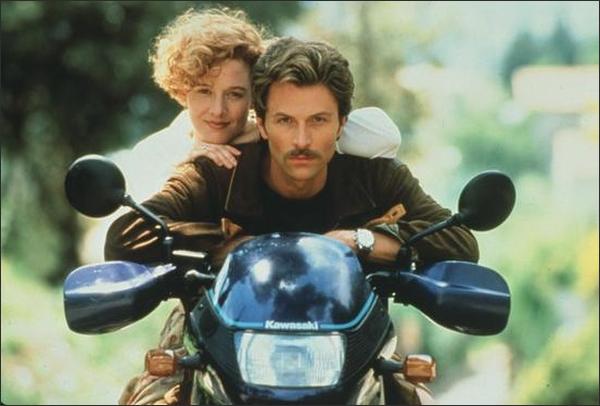Taglines: She was a nobody until someone found…
The Gun in Betty Lou’s Handbag movie storyline. Betty Lou is a librarian in a very small town. Her husband, Alex, is a police detective who takes her for granted. She is the ultimate mouse. After a gangland figure is mysteriously murdered in town, she finds the murder weapon, but can’t get anyone’s attention to tell them (we’re talking very mousy, here). Finally in a fit of frustration she fires it in a restroom and when taken to the police station insists she is the murderer. It has the desired effect, people do pay attention to her. With hints at social graces from the hookers in her cell block, she’s on her way.
The Gun in Betty Lou’s Handbag is a 1992 American screwball comedy film written by Grace Cary Bickley and directed by Allan Moyle. The film stars Penelope Ann Miller, Eric Thal, William Forsythe, Cathy Moriarty, Alfre Woodard, Julianne Moore, Andy Romano, Xander Berkeley, Reathel Bean and Christopher John Fields. Rock and roll recording pioneer Cordell Jackson played a bit part as “Bathroom Woman.”
Film Review for The Gun in Betty Lou’s Handbag
Penelope Ann Miller transcends her material in The Gun in Betty Lou’s Handbag, a half-baked Disney comedy that also half-benefits (the first half, to be exact) from the sly, subversive direction of Allen Moyle.
Betty Lou Perkins (Penelope Ann Miller), the prim assistant librarian in Tettley, Missouri (“played” by Oxford, Mississippi), is ready to explode. Her cop husband, Alex (Eric Thal, the Talmudic scholar who stoked Melanie Griffith’s religious fervor in A STRANGER AMONG US), would rather stay around the station house to investigate the town’s first murder case in a decade than come home to celebrate his wedding anniversary.
Meanwhile, a modest fundraiser Betty Lou’s supervising at her library threatens to balloon into the social nightmare of the decade as all the social climbers in the area try to put their useless two cents into the planning. Outside her work and her home, Betty Lou is further plagued by the nonstop whining of her single sister, Elinor (Julianne Moore, very funny and a ringer for Miller), but she finally topples over the edge when she can’t even get her husband on the phone to tell him she has stumbled upon the murder weapon while out walking her dog. So, instead of turning the gun in, she turns herself in as the notorious motel killer sought by Alex.
In jail she blossoms in a way she couldn’t as a cop’s wife, particularly under the fashion tutelage of her hooker-cellmate Reba (Cathy Moriarty). Alex is astounded, depressed and finally suspended from the force for interfering with the investigation of his own wife. Meanwhile, the real killer, vicious New Orleans mobster Beaudeen (William Forsythe), shows up in Tettley to retrieve an incriminating tape he believes to be in Betty Lou’s possession and kidnaps her fresh-out-of-law-school attorney Ann (Alfre Woodard); this in turn brings about the climactic husband and wife reunion.
If the mantle of auteurism has passed from the hands of directors to the heads of studio, then there’s currently no studio genre more reliably rubber-stamped than the Disney/Touchstone/Hollywood comedy. As if Disney were still making amends for the enjoyably nasty RUTHLESS PEOPLE, virtually all of them can be described thusly: “Bright start, boring end.”
Such is the case with The Gun in Betty Lou’s Handbag, yet another wacky, madcap caper comedy, despite Moyle’s (Times Square, Pump Up the Volume) hand. Yet, while it’s on, the film is a honey–sparkling, enjoyable, fast-paced, well-acted and unpredictable. But it finally paints itself into a corner, with a premise quite beyond resolution within the context of the Disney vision of cinematic domestic tranquility shored up against a dangerous, chaotic world. That world is filled with everything from all-purpose vicious gangsters (SISTER ACT and V.I. Warshawski), to scandal-mongering journalists (STRAIGHT TALK), apparent adulteresses and uninvited gays (PASSED AWAY), and, most memorably of all, mad nannies (THE HAND THAT ROCKS THE CRADLE). Whoever’s making the big production decisions at Disney must not get out much.
Moyle makes clear early on that the “gun” in Betty Lou’s handbag is carried by all women who have ever compartmentalized themselves in the lives of their men and in their workplaces only to be betrayed, disappointed and otherwise dumped on. The Gun in Betty Lou’s Handbag sets out to show us how lucky we are that most don’t use it. By a single, simple and silly act of rebellion, Betty Lou upends not only her whole town but that very Disney vision of Pollyanna life, in which men are likable lunks (modelled after Goofy?) and women are neglected, though kept superficially busy in home and out.
The Gun in Betty Lou’s Handbag dares to suggest that the Disney fantasy, attractive though it may be, would likely drive anyone actually forced to live it as nuts as it does Betty Lou, who plausibly begins to find prison a viable alternative to her Stepford life on the outside. With “family values” on everyone’s lips, someone’s bound to let the air out of these tires real quick. Betty Lou’s gun has no bullets in it at the end, either literally or figuratively. The bad guys get safely put away and everybody hugs at the end (though curiously, Ann, the only nonwhite among the principals, is still tied up at the fadeout).
The Gun in Betty Lou’s Handbag (1992)
Directed by: Allan Moyle
Starring: Penelope Ann Miller, Eric Thal, William Forsythe, Cathy Moriarty, Alfre Woodard, Julianne Moore, Andy Romano, Xander Berkeley, Reathel Bean, Christopher John Fields
Screenplay by: Grace Cary Bickley
Production Design by: Michael Corenblith
Cinematography by: Charles Minsky
Film Editing by: Janice Hampton, Erica Huggins
Costume Design by: Lisa Jensen
Set Decoration by: Merideth Boswell
Art Direction by: David J. Bomba
Music by: Richard Gibbs
MPAA Rating: PG-13 for violence, and for some sexuality and language.
Distributed by: Buena Vista Pictures
Release Date: August 21, 1992
Hits: 185
